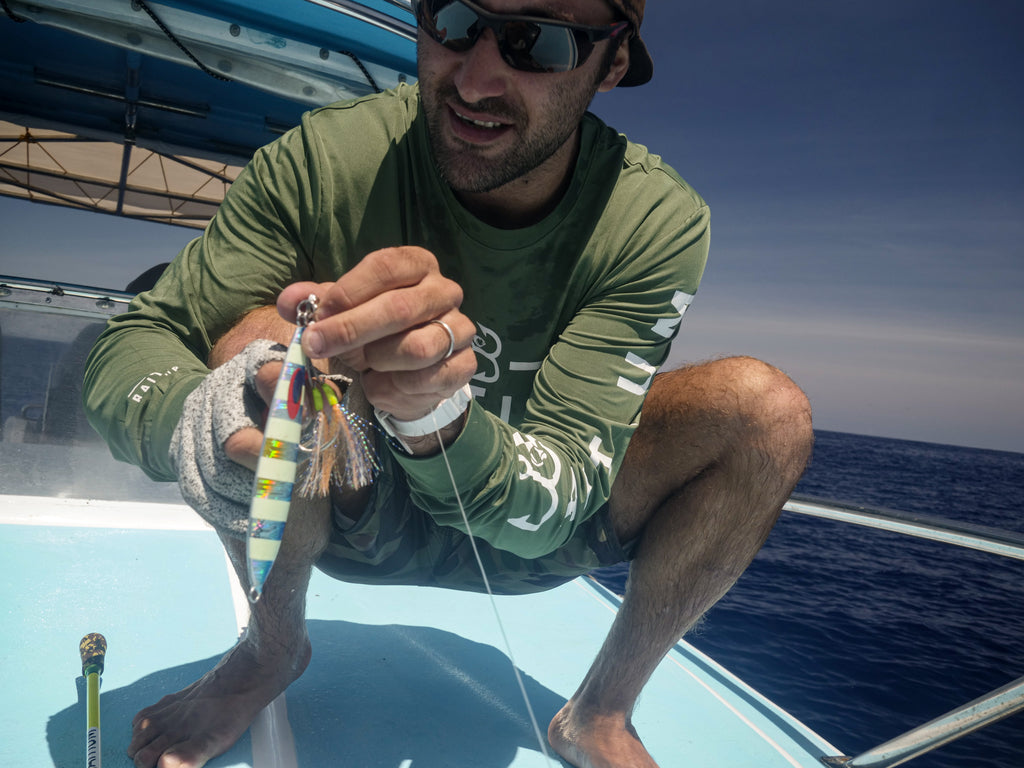Table of Contents
Lure color can be an overlooked factor in fishing, and it’s not hard to see why. After all, it is the rod and reel that you mainly use to catch fish, and in many cases, anglers prefer natural bait as terminal tackle, anyway.
But lures have a magic of their own in that they are specifically designed to entice fish through their shape, vibration, flash, or color. As I will explain in this article, color is an especially useful factor to take into consideration to attract attention. But with all the crazy colors of lures out there, it can be confusing or overwhelming. So how do you choose the right lure color?
Lures and Water Conditions
A key thing to remember is that lures can look different in various bodies of water and their varying conditions. Water has a bluish tint that gets darker as the depth increases. It can come in shades of brown and green due to sediment like clay or silt, aquatic plants, or algae. Or it can have a muddy brownish-red color because of the presence of certain plant materials or even iron in the water. Water conditions can also be clear or murky, as well as shallow or deep.
When a lure is in the water, the way its color looks can shift. The water acts as a sort of filter, kind of like how an Instagram filter or tinted lenses can alter the color of the objects viewed through them.
This color shift directly affects whether fish can see your lure at all, how visible the lure is to them, and, of course, whether it will get them to strike. In some instances, you’d want your lure to blend into the water around it, while in others you’d want it to stand out. Fish vision, according to research, isn’t the same as human vision, but that isn’t to say they can’t perceive color, either.
To make things easier, some anglers like to divide their lures into two sets: one set for clear water and another for murky water.
Crystal to moderately clear and calm water typically calls for lures with natural and lighter colors. Go for ones in white, gray, pastels, and silver, or even transparent or translucent ones. These ones are perfect as they are visible enough in the clear water but aren’t too bright and garish so as to spook fish.
However, if the water is murky, like if it has been raining, it’s best to stick to lures with darker colors like black or blue, as these can provide a good contrast against the muddy water.
If the water is greenish and murky, a two-toned lure would work great because the colors provide some contrast, increasing visibility to the fish.
Another factor to consider is the weather, particularly the amount of sunlight. Sunshine bounces off nicely against gold and silver lures, and that flash will draw the attention of fish. On cloudy days, however, a neon-colored lure will stand out and attract fish more.
Green Pumpkin Lure for Bass Fishing
You might have also heard about green pumpkin lures, a favorite among those who love bass fishing. There’s an interesting backstory to how the green pumpkin lure came about, which you can watch here.
But what you need to know, for the purpose of learning about lure colors, is that green pumpkin lures are a favorite because of their ability to match the hatch; that is, the color looks strikingly similar to the natural forage like baitfish or frogs.
Green pumpkin lures are also incredibly versatile. Anglers have reported success with using them across different locations and seasons. That isn’t to say it’s the only one bass fishers should use, because you’d also
likely catch fish with lures of other colors, like another favorite, the watermelon lure, but many anglers certainly love the green pumpkin for its advantages.
Lure Color Definitely Matters
So there you have it. Lure color matters in your fishing success. While it’s not the sole reason why the fish bite or not, it pays to know how it affects your catch rate. Again, though, if you aren't catching anything after fishing with a lure for an hour or so, consider changing your lure color and see if it works better. This will help you determine whether the problem is with your lure color or with other factors, like your casting, the water conditions, or even the time of day. Happy fishing!
MOST READ NEWS:
How To Use Your Fishing Records to Catch More Fish
Track your fishing trips, analyze patterns, and refine your techniques with a fishing log to catch more fish on every outing!
Solo Fishing Safety Tips: Stay Safe and Enjoy the Outdoors
Learn essential solo fishing safety tips: gear checklist, boat safety, emergency preparedness, weather monitoring & fishing location scouting. Stay safe on the water.
Secrets to Winter Fly Fishing Success
Master winter fly fishing with expert tips on trout behavior, essential gear, and proven techniques. Learn the secrets to catching more fish in cold weather.
How Cold Water Changes Fish Behavior: Insights for Anglers
Explore how cold water affects fish behavior and fishing techniques, enhancing your angling success and strategy.
Is Tech Making Fishing Too Easy? Exploring Forward-Facing Sonar (FFS)
Learn about forward facing sonar in fishing - what it is, how it works, rules for tournaments, ethics, and tips for finding fish with this game-changing technology.
Plan Your Best Fishing Trip Yet this 2025: A Complete Guide
Plan your fishing trip this off-season. Learn to choose destinations, prep gear, pick bait, and trust Baitium for expert tools and tips!
15 Fishing Resolutions for 2025: Set Yourself Up for Success
Discover 15 essential fishing resolutions for 2025: tackle organization, gear maintenance, angling techniques, conservation tips, tournament prep, and fishing safety guidelines.


